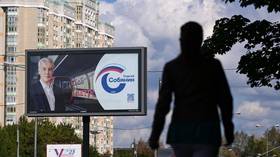Russian regional elections: Increased turnout, new voting options, and ruling party success
The incumbent mayor of Moscow was among those to retain his position, as turnout was reportedly boosted by the option to vote electronically
Russia concluded voting in regional elections in roughly one-fifth of its 89 federal subjects on Sunday, as the population elected local leaders and legislatures. In various parts of the country, including the four former Ukrainian regions that chose to join Russia last year, voters also elected representatives in the federal parliament.
In total, Russian voters cast ballots for 21 governors and lawmakers in 20 regional parliaments. Among them was the mayor of Moscow, whose office is considered particularly important due to the city’s status as the national capital and financial center.
First vote in new territories
Regional and federal elections were held in the Donetsk and Lugansk People’s Republics (DPR and LPR), as well as in Kherson and Zaporozhye Regions. All four regions became part of Russia after referendums in September 2022.
The voting period was extended by several days in areas close to the front line in the conflict with Ukraine. Residents who had fled the fighting could cast ballots at designated polling stations in other Russian regions. There was no voting in the provincial capitals of Kherson and Zaporozhye, which are controlled by the Ukrainian military.
Kiev, which claims sovereignty over the four regions, threatened criminal prosecution against anyone participating in the process as a candidate or an organizer. According to the Russian federal election authorities, a drone “destroyed” an empty polling station in an overnight attack on Sunday in Zaporozhye Region.
Ruling party triumphs
Candidates fielded by the ruling United Russia party dominated in most regions, including the four newly incorporated territories. All incumbent regional heads, most of whom are United Russia members, were re-elected by a wide margin.
Andrey Klychkov and Valentin Konovalov, both from the Communist Party, retained their respective governorships in Orlov Region in western Russia and Khakassia in southern Siberia.
In Moscow, Russia’s most-populous city and financial center, Sergey Sobyanin (United Russia) was re-elected for a third mayoral term.
The liberal Yabloko party, which has no MPs in the federal parliament, is projected to retain its representation in the city legislatures of Ekaterinburg and Veliky Novgorod. A total of nine political parties proposed candidates in the elections.
Andrey Turchak, a senior United Russia party official, congratulated supporters on “a clean and resounding victory.”
Remote voting
For the first time, Moscow allowed remote electronic voting in a mayoral election. Residents whose identities had already been verified were eligible to cast their votes using the city’s electronic services portal.
More than 3 million people, constituting some 80% of all participants, used the system in Moscow. Its popularity apparently boosted the turnout, which was recorded at 42.5%, compared to 30.9% in 2018.
A federal remote voting system was also available in other Russian regions, where it was used by over 1.7 million people. Unlike the system in Moscow, it required a preliminary request to be submitted. The Russian Digital Ministry, which supports the infrastructure, said 88% of pre-registered remote voters cast their ballots.
A total of 45 million of the 67 million eligible voters participated in the elections, marking the highest turnout since 2017, according to the Central Election Commission.
You can share this story on social media:








Comments are closed.